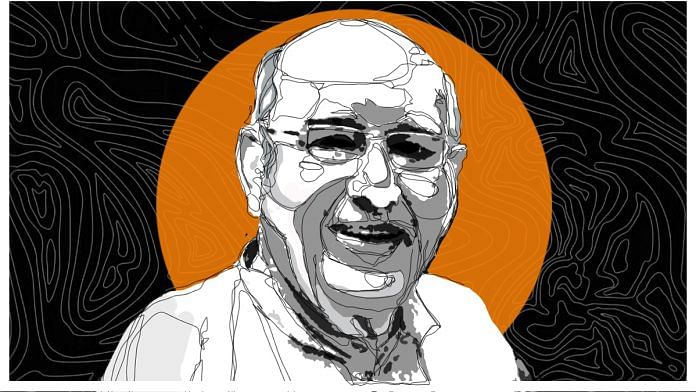New Delhi: Sudhir Dar was a man of few words, choosing to reserve his commentary for what he could convey with a brush of his pen.
“When Sudhir Dar brought his cartoons to The Statesman office, he used to send them into my office and wait around the half-opened door to hear if I laughed,” Evan Charlton, former editor of the Calcutta-based newspaper, reportedly wrote in a letter. “When I didn’t he would send in Sita Ram, our old friend and chaprassi, to have a careful look at my expression…”
Over the course of his decades-long career as a political cartoonist, the reticent illustrator would speak volumes about the state of a corrupt Indian bureaucracy through his drawings. From corrupt traders, to the whimsical and often silly adventures of the Indian police, Dar’s vision drew around the limitations of cut-and-dry newspaper headlines. He found just as much inspiration in class struggles, fashion, music, generational drifts as he did in representing governmental apathy through a visual medium.
THIS IS IT ! pic.twitter.com/U34IvfRvmo
— Sudhir Dar (@sudhirdar32) October 28, 2019
THIS IS IT ! pic.twitter.com/TClq7o0rgk
— Sudhir Dar (@sudhirdar32) October 28, 2019
The veteran cartoonist passed away Tuesday at the age of 87, after suffering a heart attack.
A life worth revisiting
Dar stands tall amid names like R.K. Laxman, Abu Abraham, O.V. Vijayan and Rajinder Puri, a generation of Indian cartoonists that we have come to associate with the smell and rustle of a newspaper. Dar was the kind of person who hoped to create a record of his cartoons by uploading photographs of old prints on Twitter — “THIS IS IT!” (the title of his cartoon series for Hindustan Times) constitutes 80 per cent of his tweets, with a few exceptions. A last nostalgic message remembering Sharmila Tagore opening his exhibition at ANZ Grindlays Bank in the 90s, was posted just a few weeks ago.
This picture of elegance n grace in HT today brings back memories of a glorious evening in d 90s , wn Sharmila n Tiger Pataudi graciously opened my exhibition at ANZ Grindlays Bank on Parliament St. n lifted d occasion .. once again , my very warm thanks ! pic.twitter.com/1qrTLlNyO1
— Sudhir Dar (@sudhirdar32) November 17, 2019
Dar appears, at least virtually, to be a man looking back at his life — revisiting memories of his interviews with unexpected foreign editors like Nick Megli of MAD Magazine (now defunct) and the time Neil Armstrong landed on the moon.
“The Hindustan Times front page on 22 July, for instance, carried a Sudhir Dar cartoon titled “An Endless List Of Firsts”, Live Mint reports, “which showed an unimpressed moon looking up at the spacecraft and the astronauts that had stepped foot on its surface. The caption said: “My first headache!”
It's d 50th annvrsy of d Moon Landing n guess wat .. here's Neil Armstrong in Delhi in '69, signing on two cartoons by Yours Truly, d suited booted baldy on d left !
Any offers ?? pic.twitter.com/PQIz2WOJvv
— Sudhir Dar (@sudhirdar32) July 14, 2019
MAD about MAD !
In '92 , when USIS asked me if I'd like to chat with Nick Meglin, Editor of MAD, I was thrilled to bits ! Here's a little flavour of that delightful exchange from SPAN magazine .. pic.twitter.com/lCuZWRMWJd
— Sudhir Dar (@sudhirdar32) July 6, 2019
A non-political political cartoonist
Dar worked at The Statesman for the better part of the 1960s, landing the job on the back of a caricature he once drew of the editor. A man with no formal artistic training, he spent the next seven years carving out his characteristic style — black and white, clean lines, accompanied by particularly terse captions.
“For his first three years as a newspaper cartoonist, Dar drew only cartoons without captions. He focused on humour, not topical comment. The comment, when it surfaced, was incidental,” veteran cartoonist and columnist Rajinder Puri wrote in 2001.
Dar moved from The Statesman to Hindustan Times in 1967, where he spent over two decades (till 1989) creating an enviable artistic oeuvre. He ended his conventional editorial career at The Pioneer, edited then by the iconic Vinod Mehta. He worked at The Pioneer from 1989 to 2000, after which he decided to segue into a less demanding freelance space.
Puri, who passed away in 2015, had recalled Dar as a professional who was “never by inclination a political cartoonist”.
“He is not a political animal. His attitude to politics is somewhat akin to what I imagine would have been the attitude of Bertie Wooster. (P. G. Wodehouse’s recurring fictional character).Dar’s forte was humour,” he wrote.
Dar’s humour — subtle, sarcastic, and tongue-in-cheek — was noticed even internationally, with The New York Times, Washington Post and Saturday Review carrying his work. Puri, however, believed Dar’s true potential was never realised.
“Had he pursued his natural inclination for pure humour and captionless cartoons, he might have developed into an icon like the cartoonists of Punch and The New Yorker,” he wrote, but “political cartooning even took a toll on his drawing style”.
Also read: It’s regressive, NYT is the loser, Indian cartoonists say as it scraps political cartoons






